|
|
 |
 |
|
|
 |
|
Luk
clutch systems
|
 |
|
|
| Historically, the core business of LuK – what many people do not know is that this abbreviation stands for “Lamellen und Kupplungsbau”, in English disc and clutch makers - is clutches, the associated systems and the dampers in the power train. LuK’s rise to success started with the standard production of the diaphragm spring clutch. Today, the range spans much more: Besides developments in the self-adjusting clutch (SAC), the term clutch systems also comprises the complex “clutch and actuation” operation and the disengaging system... |
|
 |
|
|
|
 |
|
Dual Mass Flywheel (DMF)
|
 |
|
|
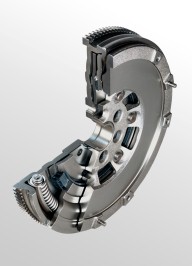 |
|
Modern engines can be driven at extremely low rpms. The trend is toward ever increasing engine torques. Wind-tunnel-optimized bodies are creating less wind noise. New calculation methods are helping reduce vehicle weights and weight-saving concepts are boosting engine efficiency as well.
The addition of a fifth or a sixth gear can also reduce fuel consumption.
Thinner oils are making precise shifting easier. In short: The sources of noise are increasing and natural damping is decreasing. What has remained is the principle of the internal combustion engine whose cyclical combustion processes excite torsional vibrations in the drive train – the unpleasant consequences of which are gear rattles and body booms. |
|
|
|
Drivers who are accustomed to increased comfort no longer accept such background noises. The job of the clutch is now more important than ever – in addition to engaging and disengaging, it must effectively insulate the engine’s vibrations. Physically, this is easy to solve: The mass moment of inertia of the transmission must be increased without increasing the mass to be shifted. This dampens the engine’s torsional vibrations and brings about the desired comfort level. The process reduces load on the transmission at the same time.
It's all in the name
LuK was the first manufacturer in Europe to develop and sell a dual-mass flywheel in large-scale standard production that was able to realize this physical principle. The name says it all: The mass of the conventional flywheel was simply split in two. One part continues to belong to the engine’s mass moment of inertia, while the other part now increases the mass moment of inertia of the transmission. The two decoupled masses are linked by a spring/damping system. One clutch disc, without a torsion damper, between the secondary mass and the transmission handles the engaging and disengaging functions. A favorable side effect is that the transmission is easier to shift because of the low mass to be synchronized, and there is less synchronization wear.
|
|
|
 |
|
Luk
clutch discs
|
 |
|
|
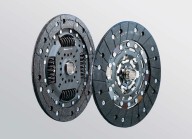 |
|
The clutch disc is the clutch’s central connection element.
In combination with the clutch pressure plate, it both separates and links engine and powertrain. It also reduces the speed fluctuations in the gearbox caused by the combustion motor. LuK offers the best solutions for every application, from clutch discs with simple torsion damper through to variants with multi-stage dampers, from rigid clutch discs for use in the dual mass flywheel right through to the displacement correction clutch disc. |
|
|
|
 |
|
Luk
clutch pressure plate
|
 |
|
|
| Diaphragm clutch
|
|
|
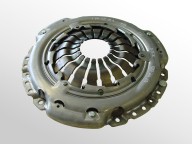 |
|
Combustion engines have a problem: They provide a usable output only in a very specific speed range – just the opposite to electric or steam engines. This means that speed, transferable engine output and gearbox must be optimally synchronised in various drive conditions – this function is provided by the clutch. The clutch separates or connects powertrain from and to the gearbox, which every driver knows from his own experience. When the clutch pedal is depressed, this powertrain is interrupted and a different gear can be engaged. |
|
|
|
 |
| SAC 1
|
|
|
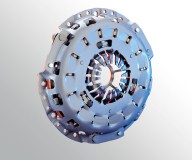 |
|
Since clutches are subject to wear during use in the vehicle, LuK, as the first clutch manufacturer, put a great deal of effort into developing a type of wear compensation system for the clutch, and put it in production in 1995. The self-adjusting clutch SAC uses a load sensor (sensor-diaphragm spring) to activate its wear compensation by turning a ramp ring. This compensation mechanism has made it possible to decrease operating loads.
The compensation for the clutch wear has also made it possible to increase the clutch service life by about 1.5 times without any significant change in the operating load over the service life. |
|
|
|
The wear adjustment system of the SAC – consisting of the sensor-diaphragm spring (load sensor) and the deep-drawn steel adjuster ring – is characterized by very high functional precision. Since a harmonic operating load curve is required in addition to comfortable clutch operation, the SAC was created with the capacity to be tuned to specific vehicle characteristic curves. One of the mechanisms that makes this possible is the compensation spring, which can generate the flatter characteristic curves that are frequently desired.
The newly developed SAC II.
provides a further optimization of the system. Here, the load sensor is not comprised of a second diaphragm spring, but rather of the sensor fingers formed from the main diaphragm spring and special tangential leaf springs with a decreasing characteristic curve.
|
|
|
 |
|
Luk clutch release systems
|
 |
|
|
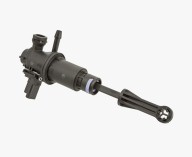

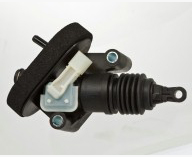
|
|
|
In terms of driving comfort, a driver evaluates the entire clutch and actuation system according to smooth disengagement behavior, the user-friendly force-travel characteristics on the clutch pedal, silent and vibration-free actuation as well as good modulation behavior during startup and gearshift operations. The entire system, from pedal to clutch, must function in all operating conditions and ensure smooth interaction with other vehicle components. Consideration of the entire chain of functions requires sub-functions in the clutch system to be carefully matched to each other.
When the clutch pedal is activated, the driver senses the clutch system's response. To satisfy the requirements placed on the clutch pedal, clutch system components must be matched in terms of friction, rigidity and mechanical advantage. The LuK product range comprises all elements for actuating manual transmissions including master and slave cylinders, mechanical lever systems with release bearings, hydraulic clutch release systems for hybrid drives, and engagement systems for wet and dry double clutch actuation systems.
Clutch master cylinder
Line technology
Slave cylinder
Vibration dampers, anti-vibration units, peak torque limiters
Lever systems with bearings
Travel and position sensors
Concentric slave cylinders located on the cover
|
|
|
|
|
 |
| |
|
|
|
|
| |
 |
 |
| |
|
|
|
|
|
 |
 |
| |
|
|
| |
Our warehouse has thousands of items ready
for delivery. Contact us for
a free quote.

|
| |

|

|

|

|

|

|
| |
|